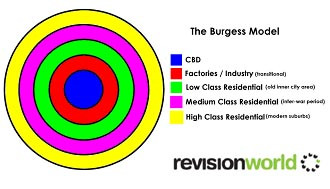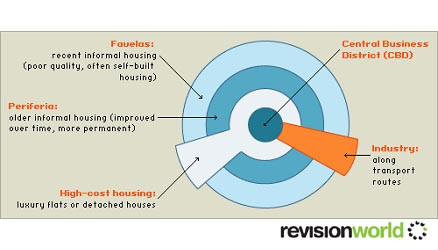Models of Land Use
Characteristics of Urban Zones
CBD
- The Central Business District is at the heart of a city where the original settlement was sited.
- Offices, shops and factories are often found here and very few residential areas.
Inner City
- The inner city zone grew during the industrial revolution. It would have consisted of a mix of densely-packed terraced homes and factories. However, many inner city housing areas have now been pulled down and replaced with high rise flats.
Suburbs
- The suburbs began to grow as cities expanded after the 1st world war. Houses are more varied and are often semi detached or detached. There are more gardens and open space.
Rural-Urban Fringe
- Different land uses are found in this area.
- Some of the land may be covered in farms, whereas other areas are covered in housing estates.
- Out-of-town shopping centres and airports are also often found in this area.
Industrial Estates
- These have been built on the fringe of many towns and cities, where there is more space for single storey factories and car parks
Burgess model for a MEDC
The Burgess model has five rings of different land uses.
The CBD (central business district) is in the middle.

The Burgess model was developed in the 1920’s and followed two main ideas.
- The most expensive land is often in the centre of the city where the CBD is located and the land on the edge of the city is cheaper.
- Cities grew outwards from the original site so the oldest buildings would be in the middle of the city and the youngest would be on the edge
Urban Modeal for a LEDC
The model below is based on cities in Brazil. The model has one similarity with the Burgess Model as the CBD is still in the centre.
However, in the LEDC model the urban zones are less defined, the high class sector is very small and close to the CBD, there are no middle class housing zones (like the suburbs of the MEDC’s), the largest zone is the shanty towns which are usually on the outskirts. Large-scale industry is often fairly recent and is sited along main routeways or around the edges.

CBD Problems of MEDC's
Traffic congestion
- Towns grew before the motor vehicle were invented so therefore most cities have not adapted easily to cope with the modern levels of traffic.
- Many local authorities have tried to solve the problem of too many cars by only allowing pedestrians in certain areas of the CBD (pedestrianisation).
- Many have built urban motorways and flyovers, ring roads and by-passes to divert traffic away from the centre. In London and other cities congestion charges aim to keep non-essential vehicles out of the CBD.
Lack of space and high cost of land
- In the CBD land is expensive and very scarce, therefore high-rise buildings have been built to combat these problems.
Urban Decline
- Some parts of the CBD have become run down and boarded up shops and offices are vandalized. This is urban decay and may be caused by competition from large out-of-town shopping centres.
Pollution
- Water, land and air pollution are very common in the city centre due to heavy traffic, large numbers of workers and nearby heavy industry.
Inner City problems with MEDC's
By the 1960’s and 1970’s large parts of inner cities were in decay.
Problems
- poor quality housing with a lack of space and with no proper kitchens, bathrooms and central heating
- a decaying environment with pollution, derelict land and a lack of open space
- unemployment due to the closure of the old-fashioned industries.
Solutions
- in some urban areas, the only solution was comprehensive redevelopment. This meant knocking everything down and starting again.
- in other cities, the local authorities were able to use urban renewal which meant taking the current housing and making it fit for modern life by knocking two houses together to create more space, by fitting central heating, insulation and new roofs, etc.
